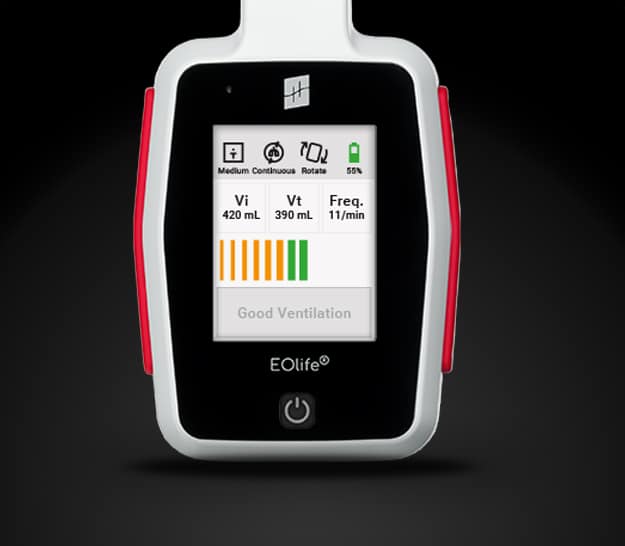The use of Ventilation Feedback Devices (VFDs) such as EOlife presents itself as a unique solution, providing real-time measurements that enhances the precision of ventilation and therefore provides the ideal conditions for favorable neurological outcomes.
Surviving a cardiac arrest stands as a testament to the advancements in resuscitation medicine, yet the path to recovery extends beyond the restoration of a pulse. The objective is not merely to save lives but to ensure that survivors can reclaim a semblance of normalcy. Inadequate ventilation during cardiac arrest management can lead to severe neurological complications. Patients’ outcomes must be addressed to improve survival quality.
While most of the research studies in the field of CPR are looking at ROSC and survival rates as the primary outcomes, the quality of life post-survival is equally crucial.

Brain injury post-resuscitation, often observed after cardiac arrest, varies in severity from mild impairment to profound brain injury and brainstem death. A study examining the enduring neurological effects of out-of-hospital cardiac arrest (OHCA) underscored the harsh truth that neurological deficits persist even in individuals successfully resuscitated. Their research reveals that merely 4.3% of survivors attain favorable neurological outcomes (CPC 1-2) five years post-event. (1).
Neurological issues, spanning from cognitive deficits to motor impairments, can significantly transform survival into an enduring challenge. While rehabilitative therapies can enhance functional abilities for some individuals, these impairments frequently hinder their capacity to work, live autonomously, and participate in basic daily tasks like bathing, dressing, and social interaction. Consequently, assessments of functional deficits after cardiac arrest and resuscitation encompass psychological challenges, as many individuals may grapple with adverse emotional effects during recovery and beyond.
Recent research conducted by Idris et al. has revealed the crucial importance of ventilation in enhancing neurological outcomes (2). The authors showed that when patients received proper ventilation – meaning adequate tidal volume – it led to a significant fivehold increase in survival with favorable neurological outcomes (10.6% versus 2.4%; P < 0.0001).
References
(1) Baldi, E., Compagnoni, S., Buratti, S., Primi, R., Bendotti, S., Currao, A., … Savastano, S.; all the Lombardia CARe Researchers. (2021). Long-Term Outcome After Out-of-Hospital Cardiac Arrest: An Utstein-Based Analysis. Frontiers in Cardiovascular Medicine, 8:764043. DOI: 10.3389/fcvm.2021.764043.
(2)Idris AH, Aramendi Ecenarro E, Leroux B, Jaureguibeitia X, Yang BY, Shaver S, et al. Bag-Valve-Mask Ventilation and Survival From Out-of-Hospital Cardiac Arrest: A Multicenter Study. Circulation 2023;148:1847–56. https://doi.org/10.1161/CIRCULATIONAHA.123.065561.

The ultimate medical device for high-performance manual ventilation.
Measure and adjust in real-time the quality of your manual ventilation. Medical device designed for the manual ventilation of adult patients in cardiopulmonary arrest.

The ultimate training tool for high-performance manual ventilation.
Record your training sessions. Analyze your ventilation cycles. Improve your manual ventilation practice.


